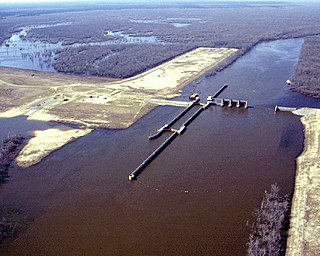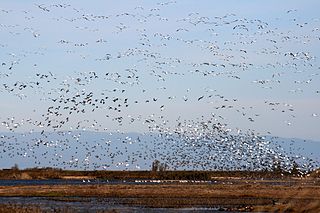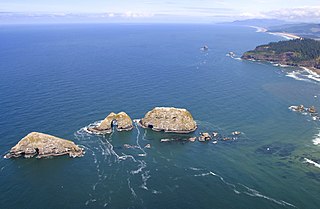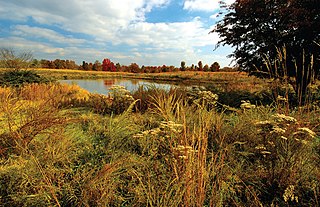Related Research Articles

The Felsenthal National Wildlife Refuge (NWR) is a 76,000 acre (307.56 km2) national wildlife refuge located in south-central Arkansas in Ashley, Bradley, and Union counties. Felsenthal NWR is one of three refuges forming an administrative complex, which also includes Pond Creek NWR to the northwest and Overflow NWR to the east.
Pond Creek National Wildlife Refuge (NWR) is a 27,300 acre (110 km2) national wildlife refuge located in Sevier County, Arkansas. Pond Creek NWR is one of three refuges forming an administrative complex, which also includes Felsenthal NWR and Overflow NWR to the east.

The Sacramento National Wildlife Refuge Complex is part of the United States system of National Wildlife Refuges (NWR). It is located in northern California, in the valley of the Sacramento River.

Ridgefield National Wildlife Refuge is a National Wildlife Refuge and is overseen by the United States Fish and Wildlife Service. The refuge borders the Columbia River and is located west of the city of Ridgefield, Washington. The wildlife haven is split by Lake River. The refuge, which provides a year-round habitat and a migration stop for a variety of bird species, protects more than 5,200 acres (2,100 ha) of marshes, grasslands, and woodlands
The Potomac Highlands of West Virginia centers on five West Virginian counties in the upper Potomac River watershed in the western portion of the state's eastern panhandle, bordering Maryland and Virginia. Because of geographical proximity, similar topography and landscapes, and shared culture and history, the Potomac Highlands region is also considered to include Pocahontas, Randolph, and Tucker Counties, even though they are in the Monongahela River or New River watersheds and not the Potomac River watershed.
The Mark Twain National Wildlife Refuge Complex was established for the protection of migratory birds including waterfowl, shorebirds, and songbirds. It is located along the Mississippi Flyway, one of the major routes for migrating waterfowl. Refuge units also provide important habitat for big-river fish and a variety of other native wildlife such as deer, fox, beaver, frogs, turtles, and snakes. Key goals are to conserve and enhance the quality and diversity of fish and wildlife and their habitats, to restore floodplain functions in the river corridor, and to provide wildlife-related recreational experiences for the public.

Mason Neck is a peninsula jutting into the Potomac River in Fairfax County, Virginia, southwest of Washington, D.C.. It is surrounded by Belmont Bay to the west, the Potomac River to the south and east, Gunston Cove to the northeast, and Pohick Bay to the north-northeast. Mason Neck forms the southernmost section of Fairfax County in Northern Virginia. It comprises an area of 20.0 square miles (51.8 km2), two-thirds of which is preserved as parkland by regional, state, and national authorities. The population of the Mason Neck CDP was 2,005 as of the 2010 census.

The 30,843 acres (124.82 km2) Chassahowitzka National Wildlife Refuge is part of the United States National Wildlife Refuge System, located on the west coast of Florida, about 70 miles (110 km) north of St. Petersburg. It is famous as the southern wintering site for the re-introduced eastern population of whooping cranes.

The Crystal River National Wildlife Refuge is part of the United States National Wildlife Refuge (NWR) System, located in Kings Bay, in the town of Crystal River, and consists of 20 islands and several small parcels of land. The 80-acre (32 ha) refuge was established in 1983, to protect the West Indian manatee.

The Passage Key National Wildlife Refuge is part of the United States National Wildlife Refuge (NWR) System, located offshore from St. Petersburg. The 64-acre (0.26 km2) refuge was established in 1905 by President Theodore Roosevelt to preserve nesting colonies of native seabirds and wading birds. The Passage Key Wilderness Area is part of the refuge, and consists of 36.37 acres (0.1472 km2) of its total area. It was established in 1970, to protect native birds and serve as a breeding ground for them.

The Pinellas National Wildlife Refuge is part of the United States National Wildlife Refuge (NWR) System, located offshore from mainland St. Petersburg, Florida, and only accessible by boat. The 394-acre (1.59 km2) refuge was established in 1951, to act as a breeding ground for colonial bird species. Islands within the refuge include Indian, Tarpon, Mule, and Jackass Keys, and all are within the St. Petersburg city limits.

Three Arch Rocks National Wildlife Refuge is a U.S. National Wildlife Refuge off the northern Oregon Coast. It is located on the central coast of Tillamook County, in the northwestern part of Oregon. It is one of six National Wildlife Refuges within the Oregon Coast National Wildlife Refuge Complex and was the first National Wildlife Refuge west of the Mississippi River. In 1970 the Refuge was designated as wilderness. It is one of the smallest wilderness areas in the United States.

Elizabeth Hartwell Mason Neck National Wildlife Refuge is a National Wildlife Refuge of the United States located in Virginia. It is part of the Potomac River National Wildlife Refuge Complex. It is on Mason Neck, a peninsula in the Potomac River that forms part of the shoreline of Belmont Bay. The refuge is adjacent to Mason Neck State Park.

The Featherstone National Wildlife Refuge is a National Wildlife Refuge located along the Potomac River in Virginia, at the point where it meets Neabsco Creek. The 325 acres (1.32 km2) of tidal marsh has been administered by the United States Fish and Wildlife Service since 1970; currently, it is part of the Potomac River National Wildlife Refuge Complex. The refuge covers wetlands and woodlands, and has a railroad right-of-way bordering its western edge. It is currently accessible only by boat, but has been considered as a possible portion of the route for the Potomac Heritage National Scenic Trail.

The Occoquan Bay National Wildlife Refuge is a National Wildlife Refuge located where the Occoquan River meets the Potomac River in Woodbridge, Virginia, United States between Belmont Bay and Occoquan Bay. The 644-acre (2.61 km2) site, about half of which is wetlands, was a popular tourist spot known as Dawson Beach until the 1940s, after which it was used for military research by the U.S. Army's Harry Diamond Laboratories from the 1960s to the 1990s. When the land was purchased from the military, it was temporarily called the Marumsco National Wildlife Refuge. The refuge was formally established and renamed in 1998, and is now managed by the United States Fish and Wildlife Service as part of the Potomac River National Wildlife Refuge Complex.

The Rappahannock River Valley National Wildlife Refuge is a National Wildlife Refuge in Warsaw, Virginia, United States that was established in 1996. It is managed by the United States Fish and Wildlife Service.

The Middle Mississippi River National Wildlife Refuge is located on the Mississippi River downstream from St. Louis, Missouri. It is managed by the U.S. Fish and Wildlife Service as part of the Mark Twain National Wildlife Refuge Complex.

The Koyukuk National Wildlife Refuge is a 3,500,000-acre (14,000 km2) conservation area in Alaska. It lies within the floodplain of the Koyukuk River, in a basin that extends from the Yukon River to the Purcell Mountains and the foothills of the Brooks Range. This region of wetlands is home to fish, waterfowl, beaver and Alaskan moose, and wooded lowlands where two species of fox, bears, wolf packs, Canadian lynx and marten prowl.
The Great River National Wildlife Refuge protects approximately 11,600 acres (47 km2) along 120 miles (190 km) of the Mississippi River, stretching north of St. Louis, Missouri. Three separate units are located in the floodplain, on both the Illinois and Missouri sides of the river.